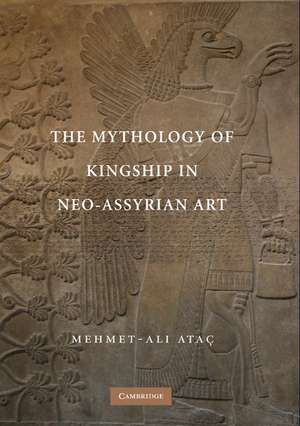The Mythology of Kingship in Neo-Assyrian Art
Autor Mehmet-Ali Ataçen Limba Engleză Hardback – 7 feb 2010
Preț: 794.03 lei
Preț vechi: 923.29 lei
-14% Nou
Puncte Express: 1191
Preț estimativ în valută:
151.94€ • 159.04$ • 126.46£
151.94€ • 159.04$ • 126.46£
Carte tipărită la comandă
Livrare economică 31 martie-14 aprilie
Preluare comenzi: 021 569.72.76
Specificații
ISBN-13: 9780521517904
ISBN-10: 0521517907
Pagini: 300
Ilustrații: 130 b/w illus.
Dimensiuni: 184 x 260 x 20 mm
Greutate: 0.79 kg
Editura: Cambridge University Press
Colecția Cambridge University Press
Locul publicării:New York, United States
ISBN-10: 0521517907
Pagini: 300
Ilustrații: 130 b/w illus.
Dimensiuni: 184 x 260 x 20 mm
Greutate: 0.79 kg
Editura: Cambridge University Press
Colecția Cambridge University Press
Locul publicării:New York, United States
Cuprins
Part I. Human and Animal Ontology in Assyrian Art: Introduction; 1. Ashurnasirpal II; 2. Tiglath-Pileser III; 3. Sargon II; 4. Sennacherib; 5. Ashurbanipal; Conclusion to Part I; Part II. Kingship and Priesthood in the Art of Ashurnasirpal II: Introduction; 6. The king, non-king; 7. 'La sale dite 'g''; 8. The mixta persona; 9. The king and the 'sacred tree'; 10. The encounter; Conclusion to Part II; Part III. The Semantics of Sages and Mischwesen in Assyrian Art and Thought: Introduction; 11. Before the flood; 12. Fertilization and purification; 13. King the man, the king-man; 14. 'Tiamat's brood'; 15. The ancient Mesopotamian flood traditions; 16. Lord of the netherworld; Conclusion to Part III; Epilogue.
Recenzii
'There is much in this book that ancient and art historians will find of interest. The method of analyzing Assyrian art in the light of the wide body of textual sources and comparative mythology is most welcome.' Bryn Mawr Classical Review
'All interested in the adaptation of primordial myth to illustrate a later art will find many thought-provoking observations in this book.' American Journal of Archaeology
'The field of ancient Near Eastern studies has traditionally been characterized by the philological virtue of attending closely to the text. Ataç's book demonstrates how this virtue is as relevant to the reading of visual material as it is to the study of verbal records.' Journal of the American Oriental Society
'All interested in the adaptation of primordial myth to illustrate a later art will find many thought-provoking observations in this book.' American Journal of Archaeology
'The field of ancient Near Eastern studies has traditionally been characterized by the philological virtue of attending closely to the text. Ataç's book demonstrates how this virtue is as relevant to the reading of visual material as it is to the study of verbal records.' Journal of the American Oriental Society
Notă biografică
Descriere
In this book, Mehmet-Ali Ataç argues that the palace reliefs of the Neo-Assyrian Empire hold a meaning deeper than simple imperial propaganda.
